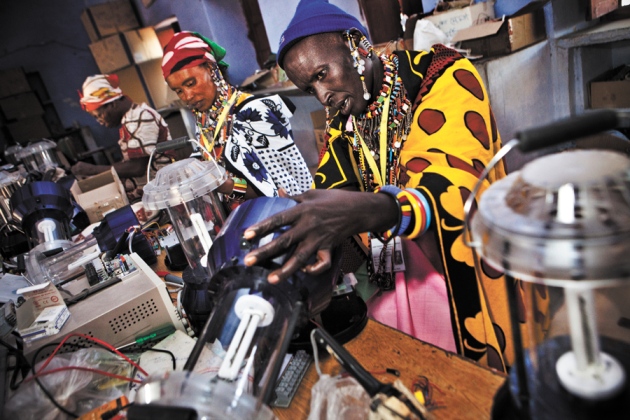Diversity: Energy studies need social science
A broader pool of expertise is needed to understand how human
behaviour affects energy demand and the uptake of technologies, says
Benjamin K. Sovacool.

Dieter Telemans/Panos
Masai women from Kenya take a course on solar energy in India.
My analysis of the peer-reviewed energy-research literature shows how biases handicap the field5. Engineers and economists are ignoring people and miscasting decision-making and action. Academic researchers frequently obsess over technical fixes rather than ways to alter lifestyles and social norms6. Interdisciplinary research remains stymied by institutional barriers in academia and government7. National and local energy bodies have conventionally had few social scientists on staff8. And most leading journals in the field focus on one discipline.
Now the energy field needs to learn from health, agriculture and business, and bring together social and physical scientists. Universities should develop courses focused on solving energy problems, granting agencies should prioritize and direct more money to behavioural work, and energy journals should broaden their scope. Already, there are promising examples of how inclusive and interdisciplinary energy research can encourage energy efficiency, and so address global environmental challenges such as climate change9.
I examined the authorship and scope of 4,444 full-length articles over 15 years (1999 to 2013) in three leading energy technology and policy journals: Energy Policy and The Energy Journal have high impact factors, and The Electricity Journal was included to sample a regulatory journal. I found four worrisome trends: an undervaluation of the influence of social dimensions on energy use; a bias towards science, engineering and economics over other social sciences and the humanities; a lack of interdisciplinary collaboration; and the under-representation of female authors or those from minority groups.
For instance, technology adoption, the complexity of choice-making, and the human dimensions of energy use and environmental change were rarely covered (see ‘Neglected topics’). Most articles (85%) focused on advanced energy-production systems, such as nuclear reactors, sources of renewable electricity and biofuels, or the technical elements of electricity generation, transmission and distribution — hardware — rather than the human 'software' behind it. Simple devices such as cooking stoves, bicycles, light bulbs and distributed generation were studied in less than 3.5% of articles. Behaviour and energy demand was investigated in less than 2.2% of papers. If this work is being published, it is in environmental sociology, psychology and political-science journals that few energy researchers read ... READ MORE
Radiotherapy in Girls and the Risk of Breast Cancer Later in Life
Wednesday, September 11th, 2015
… stem cells as a result of ionizing irradiation during puberty show a later-in-life propensity for
developing ER negative tumors – cells that do not have the estrogen
receptor. Estrogen receptors – proteins activated by the estrogen
hormone – are critical to the normal development of the breast and other
female sexual characteristics during puberty.
“Our results are in agreement with epidemiology studies showing that radiation-induced human breast cancers are more likely to be ER …
“Our results are in agreement with epidemiology studies showing that radiation-induced human breast cancers are more likely to be ER …
Liquid Fuel, from the Sun

“This is our artificial sun,” Joel Ager said, as he gestured with mock grandeur toward a metal box about the size of an old computer tower. A glowing lens, which looked like it was transplanted from a projector, shined out of a hole in its side. It was aimed at a beaker filled with water sitting a few inches away. Ager’s colleague produced a metallic toothpick-sized stick, alligator-clipped it to electrodes, and dunked it. Under the light, the submerged stick became a luminous red. “Wait for it,” Agar said. After a few seconds the red material began to emit bubbles of oxygen, slowly silvering over with tiny spheres. CLICK HERE FOR MORE INFORMATION

No comments:
Post a Comment